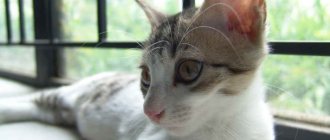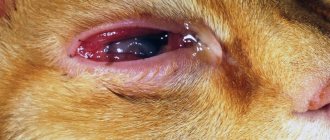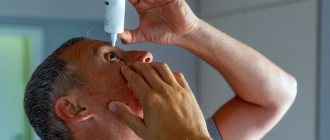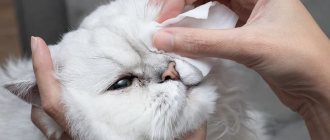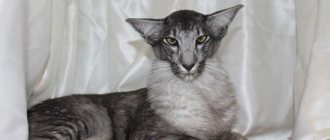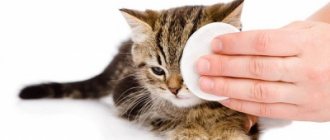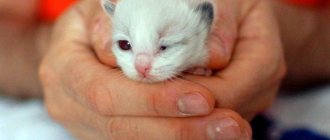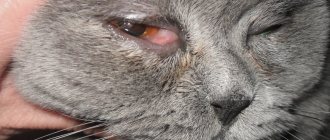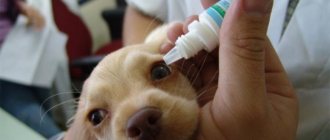Causes of tearing and souring
If your cat’s eyes are red and inflamed, there is constant tearing, accumulation of mucus, or, worse, inflammation, then this is a serious reason to immediately visit a veterinarian, who will examine the animal and determine the cause of such symptoms. The types of eye diseases in cats, like in humans, are very diverse.
Moreover, the eyes are a mirror not only of the animal’s soul, but also of the entire organism as a whole, so problems with the eyes can signal much more serious problems. Therefore, before rinsing your cat’s eyes, it would be good to determine the cause of the disease.
Inflammation can be caused by various diseases:
- conjunctivitis - inflammation of the mucous membrane, usually produces, in addition to lacrimation, purulent discharge;
- protrusion of the third eyelid - signals injury or the presence of viruses or worms in the animal’s body;
- keratitis - an inflammatory process in the cornea;
- cataract – clouding of the lens;
- glaucoma – increased intraocular pressure with clouding of the cornea;
- bulging eye - usually indicates injury or tumor;
- lacrimation - may be caused by the tear duct being blocked or producing too much tears.
Symptoms of demodicosis
Demodicosis manifests itself in 2 forms: the skin form of the disease and demodicosis of the eyelids .
With the cutaneous form of demodicosis, inflammation appears on the skin of the face, the chin, cheeks and brow ridges are especially affected. The skin of the chest and back is much less commonly affected. The main symptom of the cutaneous form of demodicosis is inflammation of the sebaceous glands and hair follicles, which leads to the formation of acne, redness of the skin and the formation of crusts.
Symptoms of demodicosis of the eyes may be as follows:
- itching and burning at the base of the eyelashes;
- eyelashes sticking together in the morning;
- rapid eye fatigue;
- dry eye syndrome;
- yellowish mucus in the eyes;
- sensation of a foreign body in the eye.
Symptoms may worsen in the morning, as well as after taking a hot bath, visiting a bathhouse or sauna, or being in the sun.
If such symptoms are detected, you should urgently consult a dermatologist (in the case of the skin form of the disease) or an ophthalmologist (in the case of eye demodicosis): the disease is contagious and quickly spreads to neighboring areas.
1 Diagnosis and treatment of demodicosis
2 Diagnosis and treatment of demodicosis
3 Treatment of demodicosis
What is the diagnosis of eye demodicosis based on?
An experienced ophthalmologist conducts special laboratory tests to identify Demodex mites, and also pays attention to the visible characteristic signs of eye demodicosis:
- redness along the edges of the eyelids;
- pustules between eyelashes;
- sticky eyelashes with a yellowish coating and scales;
- dilated capillaries of the eyelids and retina;
- thinning and frequent loss of eyelashes.
Treatment methods
If your pet has eye pain, the first thing you need to do is take your pet to the vet. The doctor will be able to make the correct diagnosis and prescribe the necessary treatment, which will include the use of medications. Usually, for diseases of the visual organ, drops are prescribed that affect the cause of the disease.
In no case should you self-medicate without making a correct diagnosis; this can harm the animal and also cause serious complications, including loss of vision.
If the disease is not advanced, then it is usually possible to get by with rinsing and instillation; sometimes special eye gels or ointments are used. In especially severe cases, the cat is given injections.
Causes of demodicosis of the eyes
This disease can appear as a result of internal factors:
- decreased immunity after illness;
- chronic microbial and viral diseases;
- the appearance of foci of infection in the body, for example, untreated caries;
- eye refractive diseases;
- hormonal disorders;
- seborrheic dermatitis;
- acne;
- disturbances in the functioning of the nervous and cardiovascular systems;
- diseases of the liver and gastrointestinal tract.
External factors can also trigger the appearance of demodicosis of the eyes:
- previous ophthalmic surgeries;
- dirty, dusty air;
- high air temperature;
- unhealthy lifestyle, alcohol abuse.
Untreated demodicosis can lead to keratitis, blepharoconjunctivitis, blepharitis and visual impairment. A deficiency of tear fluid is dangerous for the development of secondary infection.
What to wash with
In any case, in parallel with drug treatment, the doctor advises washing the animal’s eyes. Washing the eyes can be both one of the methods of treating the disease and a method of prevention.
If there is a disease of the visual apparatus with purulent discharge, it is recommended to rinse with furatsilin. It is best if the solution is prepared in a veterinary clinic, since the dilution dose should be very small - 1 mg per 5 liters of boiled water.
The cat's eye is a very sensitive organ, so even a slight excess of the dosage can cause irreparable harm to it. A two percent solution of boric acid can also be used for washing.
The question of how to wipe a kitten’s eyes, if it is healthy and the procedure is carried out as care or prevention, is decided by each owner independently. Decoctions of chamomile, sage, St. John's wort and calendula remove mucus well and have an anti-inflammatory effect. Even ordinary boiled water will do.
A healthy cat's eyes are always clear. The exception is the time immediately after sleep, when the beauty has not yet had time to put herself in order. There is no need to panic if a kitten, who was taken away from its mother early, does not yet know how to take care of itself and does not thoroughly clean its face; over time, it will learn everything and will delight its owner with the clear gaze of its naive eyes.
But if the cat constantly accumulates mucus in the corners, the eyes are red and inflamed, then this is already a cause for concern. This is a clear signal that the cat needs the help of a doctor.
In everyday life, in order not to miss the disease, it is worth examining the cat daily. If there are no strange manifestations and your pet’s eyes look healthy, then you need to clean them once a week. For this procedure, regular tea leaves or chamomile decoction are quite suitable. You need to soak a cotton swab in the liquid, and then gently wipe your eyes from the outer corner of the eyes to the inner. Kittens have their eyes washed every day until they learn to do it themselves.
How to clean your eyes
Cat's eyes are treated at home with both special preparations and improvised means.
Pharmacy products
Among the pharmaceutical products, the following are distinguished:
- Furacilin. You should purchase a solution with a concentration of 0.02%.
- Boric acid. It is used when there is no rupture of skin tissue and no bleeding.
- Saline solution 0.9%.
- Chlorhexidine.
- Potassium permanganate. The rinsing solution should be pale pink in color.
- Drops designed specifically for cats. They do not harm the kitten's body.
- Drops containing antibiotics. They are used to clean the eyes when treating conjunctivitis.
Home Remedies
You can wash your cat's eyes at home using:
- Black, weakly brewed tea. The tea should be used 10 hours after brewing.
- Herbal decoction (chamomile, St. John's wort or calendula). Brew 2 tablespoons of herb in 0.5 cups of water. After 10 minutes, you can begin the eye wash procedure.
The simplest treatment option is to wash the damaged area with warm boiled water.
How to properly wash your eyes
As a rule, cats do not like any procedures with their eyes; they can push the owner away with their paws, meow pitifully, and sometimes even defend themselves with all their claws and teeth. Therefore, the owner of the obstinate creature needs to carefully prepare for the procedure and study the question of how to wash the eyes of his pet without damaging it, and, accordingly, without allowing the cat to scratch itself.
First of all, you need to prepare everything for washing your pet’s eyes; wash your hands with soap before the procedure. It is best to swaddle your pet with a towel, otherwise the baby will struggle and scratch, certainly trying to escape. It is best to carry out eye procedures together, so that one person holds the animal, and the second performs the necessary manipulations.
Cotton swabs need to be well soaked in the prepared solution or decoction to gently soften and remove crusts before the eyes without causing pain to your four-legged friend. After the crusts have softened, the tampon is changed and the eyes are thoroughly washed so that the herbal decoction or medicinal solution gets into the eyes. You can drop the product into your eyes using a pipette.
At the end, the animal’s eyes should be wiped with a dry cloth. After all the manipulations performed, the animal must be released and treated to something tasty so that the pet relaxes and does not take offense at the owner.
However, if you teach your pet to wash its eyes from a young age, then this will not cause any difficulties later. The animal realizes that the person is helping him, so he allows him to quickly carry out all the procedures, in the hope of then getting his portion of goodies.
How to carry out the procedure?
For adult cats
For an adult animal, the visual organ is wiped from its outer corner to the inner one.
It is difficult to wash a cat’s visual organs on your own, so it is better to carry out this procedure with someone else who will hold the animal. Correctly do the washing as follows:
- Prepare the necessary equipment. Take cotton wool, a bandage or gauze pads and a syringe without a needle.
- The animal is secured so that it does not scratch the person by wrapping it in a towel.
- A gauze pad is soaked in the medicinal solution and squeezed onto the cat’s eyes.
- Wait a few minutes for the crust to become soft, and then wipe it off with a cotton pad. Movements should be from the edge of the eye to the inner corners.
- If the eyelids are stuck together, then move the cotton pad from nose to ear, replacing dirty pads with clean ones.
- The medicine is drawn into a syringe and poured onto the cleaned cornea.
- Excess drug is soaked with cotton wool or a bandage swab without touching the eyeball.
The Persian cat's eyes have a convex shape, so they are washed daily to prevent inflammation.
Newborn kitten
Kittens are born completely blind, and begin to see well after 2 weeks. The iris has a grayish, cloudy color; after a while its color changes according to the breed of the cat. In the first days of life, the kitten secretes mucus from the visual organs, which is removed by the mother cat. When kids grow up, they wash their eyes themselves, but there are times when they need outside help. A small kitten’s organs of vision are washed in the same way as an adult cat, only the treatment should be more careful and gentle. The procedure can be done by one person. After rinsing, the prescribed eye ointments are applied after 5-10 minutes so as not to cause a negative reaction between the two active ingredients.
Chemistry against panic
In cases where a pet has encountered chemicals, it is important to find out what exactly it was stained with. And then choose what to wash the kitten’s eyes with:
- Before rinsing your eye, make sure that the solution you choose does not react violently with the chemical agent;
IMPORTANT! Trying to immediately neutralize a substance is dangerous. The reaction can be violent and can further damage vision. For a short time after the chemical gets into the eye, it will be contained by the mucous membrane.
- First, rinse your eyes with water; A warm (about 35 degrees) shower or water fountain for rinsing should be “soft”;
- After washing, it will be necessary to neutralize the remaining aggressive substance. Let someone help you save time while you prepare the neutralizing solution.
- It takes 10-15 minutes to rinse the cat's eyes from chemicals with clean running water. The eyelids should be wide open (you will have to help the animal, even if it resists).
ADVICE! Almost all synthetic cleaners and detergents are slightly acidic, while natural soaps are alkaline.
Acids
After a water shower, continue to rinse with a 2% sodium bicarbonate solution (can be purchased at a pharmacy). If the pain bothers your pet too much, instilling a drop of novocaine solution (1%, for the eyes) is acceptable.
Alkalis
Alkali is quite difficult to remove from the mucous membrane. After a ten-minute rinse with water, at least half an hour of neutralization with isotonic sodium chloride (saline solution for injection) will be required. And then a 1% aqueous solution of ascorbic acid will not be amiss.
Caring for a Briton
Caring for Britons involves keeping their coat, ears, claws, eyes and teeth in order.
Wool
Since we are talking about domestic cats that do not freeze and hardly suffer from heat, the shedding process is not seasonal. The wool is replaced little by little and gradually. I consider grooming to be the most important, since the plush, shiny coat is the “calling card” of the British. Her condition is largely determined by proper nutrition . Vitamin supplements also play an important role. I use brewer's yeast, as well as wool removal paste. Be sure to keep in mind that these vitamin supplements affect the intensity of coat pigmentation, as do carrots and seaweed, which are also often found in foods and vitamins. If for black and chocolate British cats this will help to intensify and enhance the brightness of the color, then in British cats of light colors, such as blue, lilac, fawn and cream British cats, the use of these vitamin supplements will lead to a darkening of the color, which may unpleasantly surprise the expert and you . Here I will talk about cleaning and combing wool. Cleaning consists of washing with water using a suitable special shampoo for cats (do not use human or toilet soap, we do not lick our hair, the shampoo must be safe for the cat's stomach) or using a talc-based dry shampoo sold in pet stores. I like the results of using professional cosmetics for cats from BIO-GROOM (USA), the shampoos do not irritate the mucous membrane of the eyes, wash the coat perfectly without removing the natural lubricating layer, without drying out the skin, and also help to enhance its growth (noted from my own experience) )). Regarding washing a cat, I can give some advice, dictated by the regular use of this procedure in relation to the small and adult inhabitants of my cattery. Preparation: shampoo, towel, comb, hair dryer, bathtub cover, rubber mat. The first water procedure awaits a small kitten a little over a month old. Since the child is small, it is most convenient to carry out the event in a sink that has a plug in the drain hole. I take warm water (about 32 degrees, although the kitten’s body temperature exceeds 38), slowly immerse the kitten in the water, wet it well and lather it with shampoo (it’s convenient to cover the ears with cotton swabs first so that water doesn’t get inside). For soaping, I place the kitten on a board on top of the bathtub, on which I place a rubber mat. This must be done carefully and very quickly, since the heat exchange of kittens is very intense, and a kitten covered with wet fur quickly freezes. I thoroughly rinse the kitten in the sink so that the baby does not break out, you can use the “mother’s grip”, i.e. lightly grab the kitten by the scruff of the neck with one hand, place the other under its paws so that it feels supported and is not afraid. At the same time, it is very good to constantly talk to the kitten so that he hears your gentle, calm voice and does not perceive bathing as an execution. Under no circumstances make noise at the kitten or frighten it with sudden movements. Fear acquired in childhood is very persistent; later, during this procedure, serious problems may arise when the animal grows up and is able to provide serious resistance. For a small kitten that has not yet had time to pick up dirt, it is enough to soap it once. But you need to rinse it in clean water so that the water freely surrounds the kitten on all sides (so that it swims freely in it), you need to do it 2-3 times. After this, wipe dry with a towel prepared in advance and dry with a hairdryer, combing the baby with a comb. Of course, he will hide and be afraid, but your calm, confident voice will keep him from panicking. I have had cases when a kitten happily exposed its belly to warm streams of air. To be fair, it should be noted that such behavior is the exception rather than the rule))
As for my adult animals (Ginny and Grisha), I have not accustomed them to this procedure since kitten age, as a result I have some problems with washing them in the bathroom. The cat is terrified of this room, and the cat doesn’t like it either. My animals taught me the following. You should not lower the cat to the bottom of the bathtub - it cannot see the room due to the high sides, it is frightened by the lack of information and the noise of water falling into the bathtub. Now I use an intermediate option: first I use Groomer's Goop degreasing paste (it is applied to dry fur, this procedure is especially important for a cat who, due to his special sexuality, has a “greasy tail”, the paste must be on the fur for at least 5 minutes to create the desired effect ), then I wash off the paste by pouring the animal sitting on the bathtub board out of the shower. Then follows soaping twice, followed by thorough rinsing with the same shower. It’s better to have an assistant who will keep the animal from migrating under the bath)) This, of course, is worse than rinsing the cat completely immersed in water, but I can’t get the consent of my pets for this, so I water them with a shower for quite a long time, rinsing and the tummy, and the armpits, and the tail, and under the tail. The bathroom should be closed in case the cat gets scared and breaks out and runs away. Wet, she risks getting sick. After the “bath”, dry it thoroughly with a towel. After the towel, I dry the cats with a hairdryer, not with hot air, but with warm air, so as not to burn them, although they are clearly not happy with this, but since I am the main cat in the pride, they can only accept it. You have to temporarily become a multi-armed goddess to hold the cat, hair dryer and comb, since combing the hair dries faster.
Dry shampoo is a fine powder called talc. It absorbs dirt and grease and rolls into pellets. To use it, you need to lightly comb the cat's fur against its growth, sprinkle shampoo on the fur and rub it into the fur with massaging movements. I use dry shampoo topically, most often for long-haired kittens, who quite often have problems with the cleanliness of their pants and shirtfront (related to food and the reverse process). After distributing the shampoo over the cat's body, you need to comb it out. Thus, we smoothly move on to the next care procedure - combing the fur.
For this procedure, you will need several types of combs - a single-row fine comb on the handle (a comb, when purchasing, be sure to pay attention to the quality of the ends, testing with your finger so that they are not sharp and do not have metal burrs), a massage comb with metal teeth, on the tips of which there are small balls (so as not to injure the skin) - preferably several sizes (large - for the back and sides, small - for the head, tail, abdomen, neck and armpits). And finally, a brush with natural or rubber bristles to “polish” the wool. I use the first two types of combs to comb my animals both against the grain and along it. The duration of the procedure cannot be determined. This will depend on the intensity of hair loss. You will know that the end is approaching by the decrease in the amount of hair remaining on the comb. After combing with combs, I take my furry friends to the bathroom and there I remove the remaining hair with wet hands. If you are going to have a reception where your tailed pets will be shown in front of the public, you can use lotion to make the coat shine by spraying the animal and polishing the coat with a bristle brush. Experts call proper coat care grooming. With its help, you can correct defects in the exterior (often found elongated hair along the back and at the base of the tail).
Eyes
Britons' eyes can run a little, especially in kittens. If the discharge is light and dry, carefully remove it with a cotton swab or sterile cloth. To care for the eyes of cats, pet stores have a large selection of herbal lotions (Phytoelite series). “Chamomile” is used for dark discharge associated with inflammation of the mucous membrane, “Calendula” can be used for excessive lacrimation, for daily hygiene care you can choose “Green tea” or “Sage”. Never reach into a cat’s eye with unwashed hands while walking around to quickly pick off a dark speck. This can provoke a serious inflammatory process. Under no circumstances should you rush to use potent drugs. If the condition of your pet's eyes bothers you, you need to start with a well-known antiviral agent - human interferon, dissolve and drop 1-2 drops into the eyes and nose every 3-4 hours. If after three days the result is not noticeable, you can switch to the veterinary drug “Diamond Eyes”. If this does not help, contact your veterinarian, perhaps he will recommend antibiotics such as Levomecithin eye drops, Erythromycin or Tetracycline ointment. When using these medications, remember that the effectiveness of the antibiotic depends on the regimen you take the medication. And only if no other means have helped, hormonal pills and ointments are used as the last line of defense, never prescribe anything like that to your pet.
It should be noted that persistent eye problems may be a sign of some more serious disease. There are infections that have a detrimental effect on the immune system ( coronavirus , for example), and eye inflammation can be the result of a secondary infection, from which the body cannot protect itself due to weakened immunity.
Claws
Periodically (about once every 2-3 weeks) it is necessary to trim the claws on the front paws (on the hind paws you can only trim them once a month, they grow slowly). For trimming claws, use human nail clippers or special cat claw scissors, which can be purchased at a pet store. It must be taken into account that there is a blood vessel in the claw; it can be seen through the light. To access the claw, you need to sit the kitten on your lap, take the paw, lightly press the pad of your finger, and the claw will appear. Trim 1.5-2.5 mm perpendicular to the nail. Don't expect much understanding. The procedure does not bring pleasure, you can only achieve tolerance.
Don't damage the blood vessel! If this happens, disinfect as usual (for example, chlorhexidine or hydrogen peroxide). Note that the front paws have high toes. Don't forget about them.
A special scratching post is absolutely necessary for caring for claws. The cat's claw is renewed due to the desquamation of thin plates from the underside of the claw, which the cat can get rid of only by scraping its claws along a dense and fairly loose surface. Pet stores sell separate scratching posts and scratching posts combined with a cat house for these purposes. When choosing, keep in mind that a board hung on one nail will not be successful, since the reliability and solidity of this device are needed. Either such a board is firmly attached to the wall with several screws (keep in mind when choosing a height that while sharpening its claws, the cat likes to stand up to its full height and stretch), or you buy a post covered with jute rope, high enough and stable. As a scratching post, the cat also likes to use rubber mats, which I, for example, are located near the litter tray and perform a double function - barriers from the spread of litter throughout the living quarters and a means for tidying up the claws.
Ears
If your cat actively exposes its ears to you for petting and scratching, it’s most likely time to rid it of wax deposits. Although my own experience suggests that frequent ear cleaning provokes more active earwax production. Therefore, here, as in any other matter, a golden mean is needed so that, on the one hand, the cat does not become overgrown with dirt, and on the other, does not torture her with these frequent and useless procedures, since the more and more often the ear is cleaned the sooner it needs this procedure again. To do this, I use a special ear product from the BIO-GROOM series (at worst, hydrogen peroxide will do) and cotton pads. I pour peroxide into a small saucer or rosette, moisten a disk divided into two parts (one for each ear) in peroxide, squeeze it thoroughly and warm it in my fingers. During all procedures, the animal is on my lap. I stretch half a cotton pad into a “handkerchief” and put it on the tip of my finger (do not carry out this procedure with long nails!). I begin to clean the cat's ear, starting with easily accessible areas. Sometimes sulfur impurities appear in the area in front of the ears, which is sparsely covered with hair, in the form of brown sticky formations. Then I move deeper into the ear and clean there as thoroughly as possible. The cat's ear has a very difficult terrain, so be extremely careful not to scratch the delicate skin. Movements should be neat, soft and gentle, and the voice persuading the cat to be patient a little should be gentle. If you do not hurt the cat, next time she will expose her ears to you herself. Sulfur accumulations cause discomfort in the cat, and she will be grateful for your help.
Teeth
It’s worth talking about teeth, quite often their care remains “behind the scenes”, although teeth are no less important for cats than for people, but cat dental prosthetics are not practiced in our country, so you need to try to preserve the health of your cat’s teeth as much as possible at all times years of her life. As you know, a cat at home does not have the opportunity to get its teeth in order - there are no suitable twigs and grass with which it could help itself clean the spaces between its teeth. One of my cats adapted a toy mouse on a spring for this purpose. Actually, not even a mouse, but a spring. Oddly enough, she is quite successful in this procedure of cleaning her teeth with the help of such a means under her paws, and this particular cat does not have stones on her teeth, and neither does she have plaque. Every day she chews this spring for 15-20 minutes, moving it between her teeth. Among the specialized products on sale, there are toothbrushes and teeth-cleaning compositions (sets), and often the brush has the form of a cap that is put on the finger. The devices are not very convenient, they are often too large for a cat’s mouth, and not every cat will agree to such a procedure. Many manufacturers of professional food have food for removing dental plaque in their product range. It should be noted that any dry food has a cleaning effect due to the abrasive property of solid food, when when the cat chews it, it mechanically removes plaque from the tooth. Specialized foods are made in such a way that they release active substances into the saliva that help dissolve plaque. If your cat eats ready-made food, it makes sense to regularly give her special food to eliminate plaque. If the situation is advanced, and not only plaque, but also tartar has formed on the teeth, then you will have to perform a special procedure at the veterinarian to remove tartar. The bad news is that most often this procedure is performed under general anesthesia, which does not help improve the cat’s health. If you have very close contact with your cat, she completely trusts you, will allow you to perform the procedure of removing the stone, which is quite painful for her, you can do it yourself, without resorting to the help of a specialist.
You need to arm yourself with special tools, very similar to the tools of human dentists. You can buy these devices at some veterinary pharmacies. Dental pickers for cats are broadly divided into two types - the actual pickers, which have the shape of a pointed hook, which need to be operated BETWEEN the teeth, and the spatula, which is used to remove large stones from the surface of the tooth itself, usually this applies to large molars growing in the depths mouth at the jaw closure. Sometimes, to carry out the procedure, the cat’s persuasion is enough for me; I mechanically clean the stones from the teeth and between them, when the event is completed, I wipe the dentition with a well-wrung out cotton pad soaked in hydrogen peroxide. It disinfects scratches on the gums that will inevitably occur and removes plaque. But sometimes you have to swaddle the client so that his actions do not interfere with turning a cat’s grin into a Hollywood smile. Advice. If you take on a task, do not try to finish it in one go. Let the cat come to its senses, and it wouldn’t hurt for you to get distracted either. If the entire jaw is put in order in a week, it is still better than traumatizing the cat’s psyche with a visit to the veterinarian, where she will be given anesthesia, which affects both the health of blood vessels and the liver.
Is stye contagious?
It is not dangerous for others, but only if basic hygiene rules are followed. The risk of infection usually occurs in young children. Due to their age, they do not yet understand the importance of hygiene and therefore often suffer from bacterial infections. Infection is also possible when the patient uses cosmetics. But in general, isolation of an adult or child suffering from hordeolum is not required.
The causative agents of the disease are found in pus located in the barley sac. There are no bacteria on the surface. But there is usually little pus inside, so even a burst stye is not dangerous. In 80% of cases, the abscess breaks out at night when the patient is sleeping. If purulent masses end up anywhere, it is on a person’s face, his pillow, or bed linen. The infection does not spread further.
Traditional preparations for washing the eyes
If for some reason the kitten’s owner does not want to use medical solutions for rinsing or they simply are not at hand, but immediate assistance is required, unconventional drugs can be used. It is important to follow the dosages of the components used and not exceed the recommended number of medications.
Table 1. Traditional methods for washing the eyes of kittens.
| Ingredient | Cooking method | Dosage | A course of treatment |
|
| Until symptoms are completely cured | |
|
| No more than 3-5 days | |
|
| Until symptoms are completely suppressed | |
|
| Until symptoms are completely eliminated |
Attention! Manganese solution should be used with great caution in treatment. It is necessary to achieve complete dissolution of the crystals so that they do not burn the cornea and adjacent skin.
Ready-made calendula solution for washing
Medicinal eye washes
Diamond Eyes Drops
An effective medication for suppressing many visual disorders. The drops contain taurine and succinic acid. This combination produces a powerful antibacterial and decongestant result, relieves severe and mild inflammatory processes. Used to eliminate infectious lesions, dissolve crusts in the corner of the eyes, treat acute and chronic conjunctivitis, and are suitable for the complex treatment of allergic reactions.
When using Diamond Drops, the following dosages are observed:
- to wash the exudate and treat mild chronic conjunctivitis, it is enough to use 1 drop of solution every 5-10 days; the product can be used up to three times a day;
- if the kitten’s condition requires taking medication daily, you cannot use it for more than 45 days, after each course there is a break of 10 days;
- with double treatment, eye drops cannot be instilled every day for more than 20 days, the break after each course is one week;
- with three treatments every day, eye drops cannot be used for more than two weeks; after each course, a break of at least five days is required;
- If your pet is diagnosed with increased tear secretion, redness, foreign body penetration and injury, it is recommended to prescribe drops three times a day for no more than two weeks.
The drops are well tolerated by kittens and, if the dosage is observed, do not provoke any negative reactions.
Veterinary drug Diamond eyes for prevention and treatment
Saline solution at a concentration of 0.9% of the active substance
It must be purchased only in pharmacies; it is very difficult to independently bring the concentrate to the required dose of 0.9%. If this amount of active substance is exceeded, there is a high risk of redness and burns of the eyeball. The solution is used up to three times a day for external treatment of the eye. If necessary, it can be used dropwise in one dose no more than twice a day. Duration of use – up to two weeks.
Ophthal
Drops are used to eliminate irritation due to sand, dust, and the release of tears during an allergic reaction. Use the medication for no more than three days at a concentration of 0.5 mg/ml of the active substance. For rinsing and treatment, it is enough to instill one drop of Ophthal no more than twice a day.
Ophthal drops for treating and washing the eyes of kittens
Dewdrop
Hygienic lotion based on chamomile and sage. Used to remove dust, dirt, accumulated exudate, and additionally cares for the skin. Well tolerated by kittens. To eliminate the problem, you need to moisten a sterile swab with lotion and soften the accumulated crusts with it. Once they are removed, you should wipe the eye again. Treatment is carried out once a day, if necessary, a repeated procedure is allowed. Between uses of Rosinka lotion, a 5-10 day break is required for regular care.
Anandin
Drops prescribed in the presence of increased lacrimation due to allergic rhinitis or conjunctivitis. Taking into account the severity of the kitten’s condition, 1-2 drops of the drug are instilled into the lower eyelid no more than twice a day. Sometimes a single dose can be increased to 2-3 drops, but usually this dosage is used only for adults. The recommended course of therapy is no more than two weeks.
Read more about the use of the drug "Anandin" for cats, the characteristics of the drug, and side effects here.
Types and stages of development of hordeolum
Depending on the location of the lesion, it can be of the following types:
- External stye
. More common according to statistics. The infectious-inflammatory process is localized at the edge of the eyelid, since the infection settles in the sebaceous gland of Zeiss or in the ciliary bulb. - Internal stye on the eye
. It has another name - meibomite. It is caused by the penetration of pathogenic microorganisms into the passage of the meibomian glands located on the back side of the eyelid margin.
By type they distinguish:
- Hot barley
. It is characterized by the classic development of the disease; infection is localized in the ciliary pocket - the bulb or Zeiss gland. With therapy it goes away in about a week. - Cold stye (chalazion, meibomian cyst)
. The inflammatory process affects the meibomian glands. It develops very slowly. Recovery takes 1–2 months. If there is a very large stye, surgical removal is possible.
Inflammation goes through the following stages:
- Formation of a purulent core
. A small reddish swelling causes discomfort when moving the eyelids. - Formation of an abscess
. The patient’s condition at this stage can only be alleviated by medications. - Breakthrough of pus.
It does not indicate recovery, but the patient feels much better. During this period, you need to keep your eyes clean and use prescribed medications and ointments.
